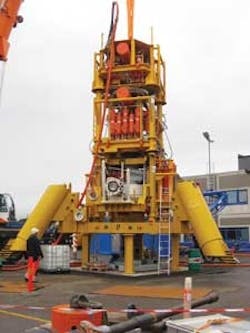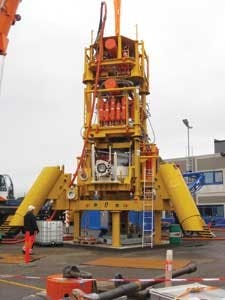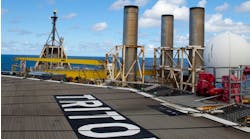Bruce Beaubouef • Houston
The Bureau of Ocean Energy Management (BOEM) has announced its proposed outer continental shelf (OCS) oil and gas leasing program for 2012–2017.
The plan focuses on exploration in the Gulf of Mexico; proposes three auctions in the Arctic; and rules out development in unexplored areas along the Atlantic coast.
In all, the Interior Department will hold 15 lease sales in six offshore areas, including the eastern Gulf of Mexico, near an area where development is currently off limits under a federal ban.
The following sales are included in the proposed program:
- Western GoM: Five annual area-wide lease sales beginning in the fall of 2012 that make available all unleased acreage
- Central GoM: Five annual areawide lease sales beginning in the spring of 2013 that make available all unleased acreage
- Eastern GoM: Two sales, in 2014 and 2016, in areas of the eastern Gulf that are not currently under congressional moratorium
- Beaufort Sea: One sale in 2015 with time to learn from any interim exploration and further analyze environmental issues, subsistence use needs, and infrastructure capabilities
- Chukchi Sea: One sale in 2016, with time to learn from any interim exploration and further analyze environmental issues, subsistence use needs, and infrastructure capabilities – so that the lease sale can be tailored to balance these issues
- Cook Inlet: One special interest sale including the entire planning area, which is initially scheduled for 2013, but may be moved to later in the program depending on industry interest in the sale.
Interior Secretary Ken Salazar described the new proposal as an expansion of "safe and responsible oil and gas production from the outer continental shelf" that would "help us continue to reduce our dependence on foreign oil." He said that the program would make available more than 75% of the oil and gas resources that the government estimates are under the outer continental shelf and deemed to be technically recoverable.
FMC sets new deepwater completion record in GoM
FMC Technologies, Inc. reports that its enhanced vertical deepwater tree (EVDT) system has set a new deepwater completion record of 9,627 ft (2,934 m). The world record depth was achieved at the Shell-operated Tobago field, part of the Perdido development located in the Gulf of Mexico.
The new depth record surpasses the previous milestone of 9,356 ft (2,852 m) that was established in 2008 at Shell's Silvertip field, which is also a part of the Perdido development. That record was also achieved with an FMC-designed EVDT, a subsea oil and gas production tree system that earned FMC the 2008 Spotlight on New Technology Award at the energy industry's Offshore Technology Conference in Houston.
Located on Alaminos Canyon Block 815, Shell's Perdido development includes the Great White, Silvertip and Tobago fields. FMC's overall scope of supply for the project has included 25 subsea trees pressure rated at 10,000 psi, five subsea caisson separation and boosting systems, two subsea manifolds and related controls and equipment. Shell operates the Tobago field on behalf of partners Chevron, Unocal and Nexen.
Petrobras strikes oil in deepwater Walker Ridge area
Petróleo Brasileiro S.A (Petrobras) has announced a new oil strike at the southeast end of its Walker Ridge concession area in the Gulf of Mexico.
Petrobras has announced a new oil discovery at the southeast end of its Walker Ridge concession area in the Gulf of Mexico, some 400 km (250 mi) southeast of New Orleans.
The Logan discovery is 400 km (250 mi) southeast of New Orleans, at a water depth of 2,364 m (7,750 ft). The discovery is by well WR 969 #1 (Logan #1), in block WR 969. New exploratory activities will determine the recoverable volumes and commerciality.
Statoil is the operator with a 35% interest. Petrobras América Inc. holds 35%, while Ecopetrol America and OOGC have a 20% and a 10% interest, respectively.
Hess to proceed with Tubular Bells
Hess Corp. has announced plans to proceed to develop the deepwater Gulf of Mexico Tubular Bells oil and gas project, subject to receipt of the necessary government permits.
The plan initially calls for three subsea production wells and two water injection wells from two subsea drill centers tied back to a third-party owned spar production facility, the first of its kind to be constructed entirely in the United States. Drilling is scheduled to begin in 2012 and initial production is expected in 2014.
The development is estimated to cost $2.3 billion, with additional commitments for production handling, export pipeline, and oil and gas gathering and processing services.
Annual gross production is expected to peak in the range of 40,000-45,000 boe/d. Total estimated recoverable resources for Tubular Bells are estimated at more than 120 MMboe.
Hess will hold a 57.14% interest in the field and Chevron U.S.A. Inc. will hold the remaining 42.86%.
Tubular Bells was discovered in 2003, along with a number of other deepwater finds.
Offshore Articles Archives
View Oil and Gas Articles on PennEnergy.com





